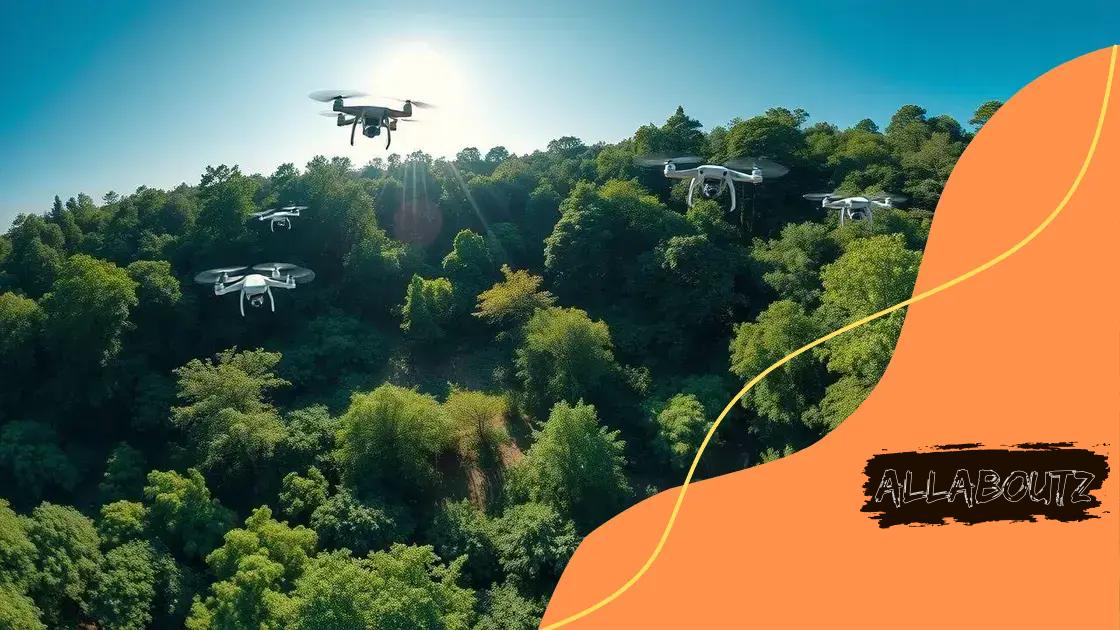Drones for wildlife conservation efforts: a game changer

Drones for wildlife conservation provide real-time monitoring and data collection, enhancing protection efforts through improved tracking, reduced human impact, and innovative technological advancements.
Drones for wildlife conservation efforts are becoming indispensable tools in protecting our planet’s biodiversity. Have you ever wondered how these unmanned aerial vehicles can change the future of wildlife protection? Let’s dive in!
How drones are used in wildlife surveys
Drones are revolutionizing how we conduct wildlife surveys. With their ability to cover large areas quickly and collect valuable data, they are becoming essential tools for conservationists. These unmanned aerial vehicles provide insights into wildlife populations and habitats like never before.
Efficiency and Coverage
One of the biggest advantages of using drones in wildlife surveys is their efficiency. Drones can cover vast areas in short periods, allowing researchers to collect data that would take much longer if done on foot.
Data Collection Methods
Drones are equipped with various sensors to collect different types of data. For example, some use high-resolution cameras to capture images of wildlife, while others are fitted with thermal imaging sensors to spot animals in dense vegetation or at night.
This technology enables researchers to gather important information such as population counts, migration patterns, and habitat use. Using drones allows for a safer, faster, and less invasive approach when studying wildlife.
Moreover, the data collected can be analyzed using advanced software, providing even deeper insights into animal behavior and habitat preferences. These insights are crucial for developing effective conservation strategies.
Real-World Applications
Various organizations worldwide are already using drones for wildlife surveys. For instance, in the Amazon rainforest, drones are employed to monitor endangered species and track illegal poaching activities. By incorporating drones into their operations, conservationists can act swiftly and effectively.
The impact of drones on conservation efforts
The impact of drones on conservation efforts is profound and wide-ranging. These tools are changing how we monitor and manage wildlife and natural resources. With their aerial views and advanced technology, drones are making data collection faster and more effective.
Enhanced Monitoring
Drones provide real-time data and imagery that help researchers monitor animal populations and track habitat changes. They can easily cover vast areas that might be challenging for people to access on foot.
Creating Effective Conservation Strategies
The data gathered by drones plays a critical role in shaping conservation strategies. By observing animal behavior and habitat conditions, conservationists can better understand what measures are needed to protect vulnerable species.
The use of drones helps identify areas that require immediate attention, such as regions facing habitat loss or illegal poaching. With this information, organizations can allocate resources more efficiently and create targeted action plans.
For instance, drones equipped with thermal imaging can detect poachers at night, dramatically increasing the chances of preventing wildlife crimes. Furthermore, tracking migrations has become more efficient, allowing conservationists to ensure safe passages for migrating animals.
Community Engagement and Education
Drones also foster community engagement by providing visuals that illustrate the importance of conservation efforts. Educational programs using drone footage can raise awareness and inspire action among local communities.
Case studies of successful drone missions

The use of drones in conservation has led to numerous successful missions worldwide. These case studies highlight the effectiveness of drones in a variety of contexts, proving their value in protecting wildlife and natural habitats.
Monitoring Sea Turtles
In one remarkable case, researchers used drones to monitor sea turtle populations on remote beaches. The drones provided aerial views that helped identify nesting sites without disturbing the turtles. This efficient monitoring allowed scientists to gather data on hatching success rates and predator interactions.
Tracking African Elephants
Another compelling example involves tracking African elephants in their natural habitat. Conservationists employed drones equipped with high-resolution cameras to monitor herd movements. This real-time tracking helped prevent human-elephant conflicts and identify vital migration routes.
By understanding elephant behavior better, conservationists were able to engage local communities in protection efforts, reducing incidents of poaching.
Documenting Illegal Fishing Activities
Drones have also played a crucial role in combating illegal fishing. In various coastal regions, drones are used to patrol marine protected areas. They provide live feeds, helping authorities identify unauthorized fishing without risk to their personnel.
This proactive approach has led to the apprehension of numerous illegal fishers and has raised awareness about the importance of protecting marine biodiversity. With the aid of drones, conservationists can monitor vast ocean areas more effectively than ever before.
Challenges in using drones for wildlife conservation
Using drones for wildlife conservation presents exciting opportunities, but several challenges come with these advanced technologies. Understanding these challenges is crucial for maximizing their effectiveness in protecting our natural resources.
Regulatory Issues
One significant challenge is navigating the legal and regulatory landscape surrounding drone use. Different countries have varying laws regarding where and how drones can be flown. These regulations can impact conservation efforts, as researchers need permits that often take time to obtain.
Technical Limitations
While technology is rapidly advancing, drones still face some limitations. Battery life is a common issue, often restricting flight time and area coverage. In remote areas, power sources may not be readily available, limiting the effectiveness of monitoring.
The reliability of drones can also pose challenges. Environmental conditions, like wind and rain, can affect the performance of these machines. Consistent data collection requires careful planning and execution in varying weather conditions.
Costs and Funding
Implementing drone technology for conservation efforts can also be costly. High-quality drones with advanced sensors are expensive and require trained personnel to operate. Securing funding for these projects often becomes a hurdle for organizations.
Moreover, ongoing operational costs, such as maintenance and data analysis, can strain budgets. Many conservation groups struggle to find sustainable funding sources to support these initiatives.
Future innovations in drone technology for conservation
The future of drones in conservation looks bright, with several innovations on the horizon. As technology continues to advance, we can expect even more effective tools for wildlife protection and monitoring.
Advanced Sensing Technologies
One key area of innovation is the development of advanced sensing technologies. Future drones will incorporate improved sensors that provide real-time data on wildlife and their habitats. These sensors might include multispectral imaging, which can capture not just visible light but also infrared and ultraviolet wavelengths.
Increased Autonomy
Another exciting development is the potential for increased autonomy in drones. With advancements in artificial intelligence, future drones could operate with little human intervention. They might be able to navigate complex environments, avoid obstacles, and make decisions based on the data they collect.
This autonomy will allow conservationists to deploy drones in remote areas more effectively, ensuring that even hard-to-reach wildlife populations are monitored. As drones become smarter, they will become even more integral in conservation efforts.
Collaboration with Other Technologies
The future will likely see drones working in tandem with other technologies, such as satellite imagery and ground-based sensors. This collaboration will provide a comprehensive view of ecosystems, enhancing overall conservation strategies.
As these technologies combine, they will help create a more holistic approach to wildlife conservation, offering deeper insights and more effective strategies.
FAQ – Frequently Asked Questions about Drones in Wildlife Conservation
How do drones improve wildlife monitoring?
Drones enhance wildlife monitoring by providing real-time data and aerial views, making it easier to track animal populations and their habitats.
What are the main challenges of using drones for conservation?
The main challenges include regulatory issues, technical limitations like battery life, and the costs associated with acquiring and operating drone technology.
What future innovations can we expect in drone technology for conservation?
Future innovations may include advanced sensing technologies, increased autonomy with AI, and better collaboration with other monitoring technologies.
How can drones help engage local communities in conservation efforts?
Drones can provide visual data and insights that educate and raise awareness about conservation issues, encouraging local communities to participate actively.





